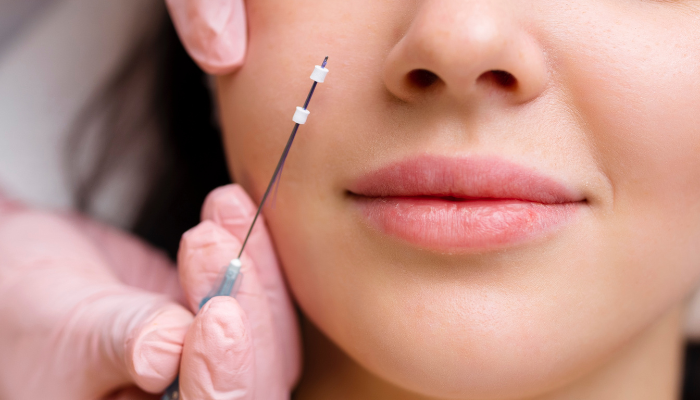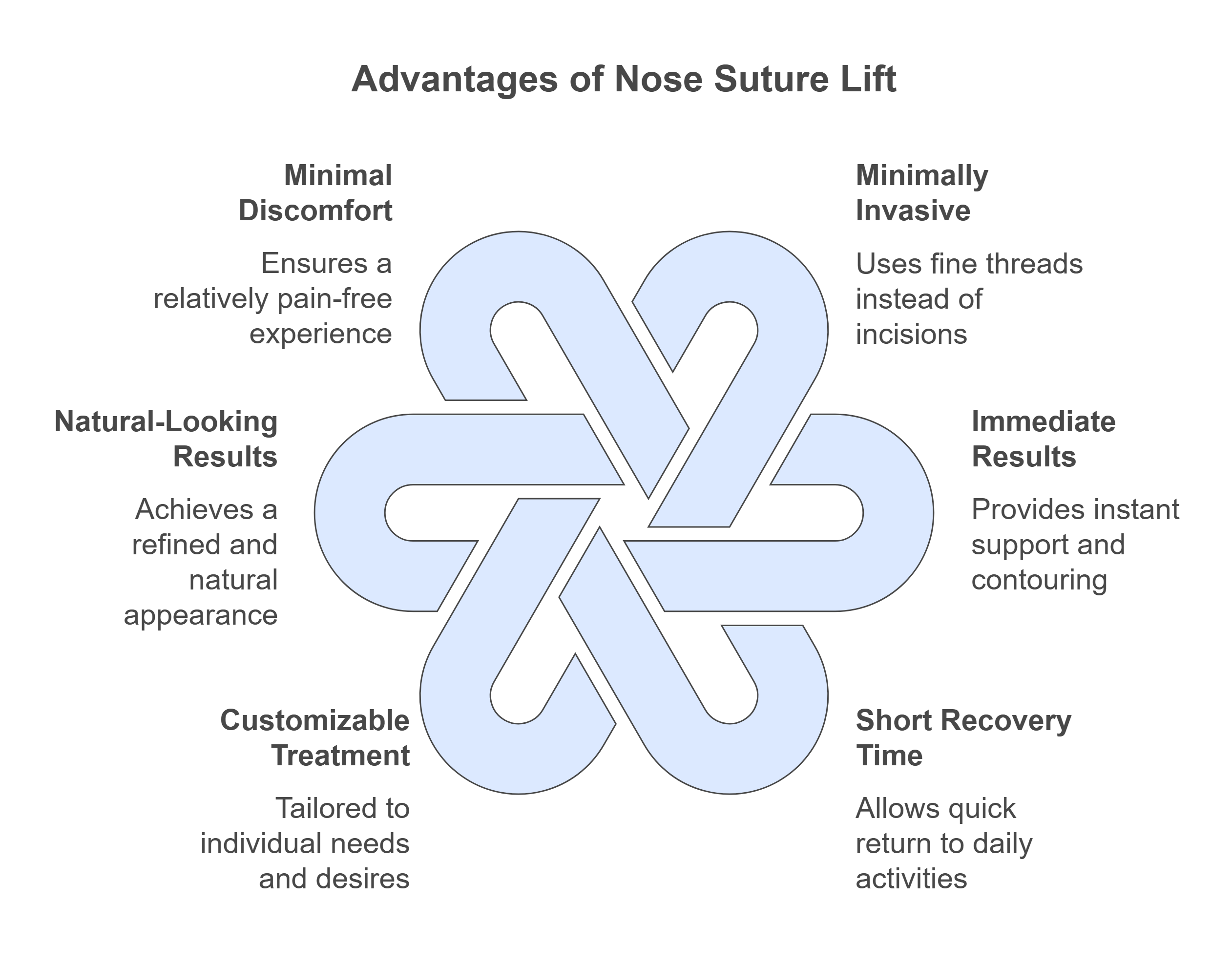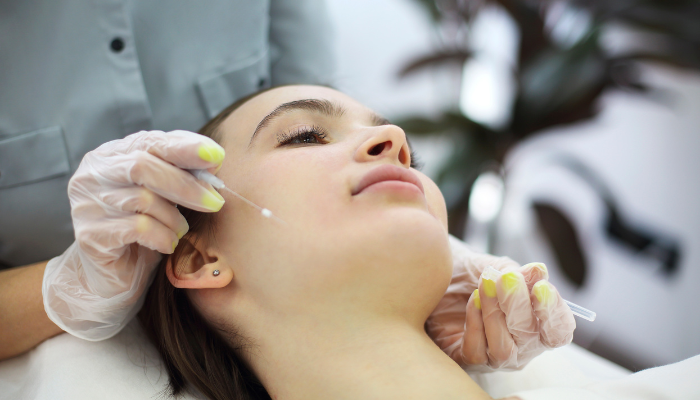If you’re looking for a way to lift and tighten your skin without going under the knife, a barbed suture lift might just be the solution for you.
This innovative procedure uses specially designed threads to provide an instant lift while also stimulating collagen production for long-lasting results. In this article, we will explore the ins and outs of the barbed suture lift, its benefits, and what you can expect from the procedure.
Key Takeaways
- Barbed suture lifts use threads with tiny barbs to lift and support sagging skin.
- The procedure is minimally invasive, offering quick recovery and immediate results.
- Suitable for various skin types, it’s ideal for those with mild to moderate sagging.
- Post-procedure care is crucial for achieving optimal results and minimising complications.
- Comparing costs and effectiveness with traditional facelifts helps in making an informed decision.
Understanding Barbed Suture Lift Techniques
What Is a Barbed Suture Lift?
What exactly is a barbed suture lift? Well, it’s a minimally invasive cosmetic procedure designed to lift and tighten sagging skin using special threads that have tiny barbs or hooks on them. These barbs grip the underlying tissue, allowing the practitioner to lift and reposition the skin without the need for surgery.
Think of it as a clever way to achieve a more youthful appearance without going under the knife. It’s gaining popularity, and for good reason – it’s quick, relatively painless, and offers noticeable results.
How Does It Work?
The magic of a barbed suture lift, also known as a thread lift, lies in the design of the threads themselves. Once inserted beneath the skin, these threads act like scaffolding, providing support and lift. The barbs anchor to the tissue, and when the thread is pulled, it lifts the skin into a more desirable position. But it’s not just about the immediate lift.
Over time, the threads also stimulate collagen production, which helps to improve skin elasticity and firmness. It’s a two-pronged approach: immediate gratification and long-term benefits.
Differences Between Barbed and Smooth Threads
When it comes to thread lifts, you’ve got two main contenders: barbed and smooth threads. The key difference? Those little barbs.
- Barbed threads: These are your lifting champions. The barbs provide a strong grip, making them ideal for lifting sagging skin and repositioning tissues. They’re often used in areas where a more significant lift is desired.
- Smooth threads: These are more about collagen stimulation and subtle tightening. They don’t have barbs, so they don’t provide as much lift. Instead, they create a mesh-like structure under the skin, encouraging collagen production and improving skin texture.
Choosing between barbed and smooth threads depends on your individual needs and desired results.
Here’s a quick comparison:
| Feature | Barbed Threads | Smooth Threads |
|---|---|---|
| Lifting Effect | Strong | Subtle |
| Collagen Stim. | Moderate | High |
| Best For | Sagging skin, repositioning tissues | Fine lines, skin texture improvement |
| Downtime | Slightly longer due to potential for bruising | Minimal |
Ultimately, the best type of thread for you will depend on your specific goals and the advice of your practitioner. They’ll assess your skin and recommend the most appropriate option to achieve the results you’re looking for.
Key Benefits of Barbed Suture Lift
Minimally Invasive Procedure
Let’s be honest, the idea of going under the knife or rhinoplasty isn’t exactly appealing, is it? That’s where the barbed suture lift really shines. It’s a minimally invasive procedure, meaning smaller incisions and less disruption to your life. Instead of extensive surgery, specialised sutures are inserted just beneath the skin to lift and support sagging tissues.
This translates to reduced scarring, less pain, and a quicker recovery compared to traditional facelifts. It’s a win-win!
Immediate Results
One of the most exciting aspects of a barbed suture lift is that you’ll see a difference almost straight away. While there might be some initial swelling, you’ll notice a visible lift and tightening of the treated areas pretty quickly.
The full results will continue to develop as collagen production is stimulated, giving you a refreshed and rejuvenated appearance over time.
Long-Lasting Effects
Okay, so it’s not a permanent solution, but the effects of a barbed suture lift can last a good while. We’re talking anywhere from 12 to 24 months, sometimes even longer, depending on factors like your age, skin type, and lifestyle.
Plus, the procedure stimulates collagen production, which helps to maintain the lift and improve skin quality even after the sutures have dissolved. It’s an investment in your appearance that keeps on giving.
Think of it as a really good haircut. It looks great right after you get it, and it continues to look good for weeks afterwards as it grows out. A barbed suture lift is similar – you get that initial lift, and then the benefits continue as your skin produces more collagen.
Ideal Candidates for Barbed Suture Lift
Who Can Benefit?
So, who’s the ideal person for a barbed suture lift? Generally, it’s those experiencing mild to moderate sagging of the face or neck. Think of it as a great option if you’re noticing the early signs of ageing but aren’t quite ready for a full-on facelift.
It’s particularly effective for lifting the cheeks, defining the jawline, and reducing the appearance of jowls.
- People with realistic expectations are key.
- Those who want a subtle, natural-looking lift.
- Individuals who prefer a minimally invasive procedure.
It’s worth remembering that a barbed suture lift isn’t a substitute for a surgical facelift. It’s more about refreshing your appearance and addressing early signs of ageing.
Age Considerations
Age plays a role, of course. Typically, the best candidates are in their late 30s to early 50s. This is when skin still has good elasticity and can respond well to the lifting effect of the sutures.
Someone in their 60s with good skin quality might still be a suitable candidate, while someone younger with significant sun damage might not see the best results.
Skin Type and Condition
Your skin’s condition is a big factor. The ideal candidate has relatively thick skin with good elasticity. Thin skin might not provide enough support for the sutures, and very loose skin might require a more invasive procedure.
Also, it’s important to have healthy skin, free from active infections or inflammatory conditions. If you’ve got a history of keloid scarring, it’s something to discuss with your practitioner, as it could affect the healing process.
The Procedure: What to Expect
So, you’re considering a barbed suture lift? Let’s walk through what you can expect, from the initial consultation to the aftercare.
Consultation and Assessment
First things first, you’ll have a consultation with a qualified practitioner. This is where you discuss your goals, and they assess your skin and facial structure. They’ll want to know about your medical history, any medications you’re taking, and your lifestyle habits. Be honest – it all matters!
The practitioner will examine your face, paying close attention to areas of sagging or volume loss. They’ll explain the procedure in detail, including potential risks and benefits, and answer any questions you might have. This is also the time to discuss realistic expectations. It’s important to remember that a barbed suture lift is not a surgical facelift, and the results will be more subtle.
Pre-Procedure Guidelines
Now comes the prep. Your practitioner will give you a list of things to avoid in the days leading up to your appointment. This usually includes:
- Blood-thinning medications like aspirin or ibuprofen.
- Alcohol, as it can increase bruising.
- Certain supplements, such as fish oil or vitamin E.
- Smoking, as it impairs healing.
You’ll also be advised to stay hydrated and to inform your practitioner of any changes in your health. It’s all about setting yourself up for the best possible outcome.
Post-Procedure Care
So, the procedure is done! What now? Post-procedure care is key to ensuring optimal results and minimising complications. You can expect some bruising, swelling, and mild discomfort in the treated areas.
This is normal and should subside within a week or two. Your practitioner will provide you with specific instructions, which may include:
- Applying cold compresses to reduce swelling.
- Taking pain medication as needed.
- Avoiding strenuous activities for a week or so.
- Sleeping on your back with your head elevated.
- Avoiding excessive facial movements.
It’s really important to follow these instructions carefully. Don’t be afraid to contact your practitioner if you have any concerns or questions. They’re there to support you through the healing process. Remember, patience is key! The full results of your barbed suture lift will become more apparent over the following weeks and months as collagen production increases.
Potential Risks and Considerations
Like any cosmetic procedure, it’s important to be aware of the potential downsides of a barbed suture lift. While generally safe, it’s not without its risks. Understanding these beforehand will help you make an informed decision and manage your expectations.
Common Side Effects
Okay, so what can you expect right after the procedure? Well, most people experience some degree of swelling and bruising. It’s pretty normal, and usually fades within a week or so.
You might also feel some tenderness or discomfort around the treated area. Pain is usually mild and manageable with over-the-counter pain relief. Some people also report temporary numbness or tingling. Here’s a quick rundown:
- Swelling and bruising (usually subsides within a week)
- Tenderness or mild pain
- Temporary numbness or tingling
- Slight bleeding at the insertion points
Managing Expectations
It’s really important to have realistic expectations. A barbed suture lift can provide a noticeable lift and rejuvenation, but it’s not a replacement for a traditional facelift. The results are more subtle, and the longevity varies from person to person.
Factors like your age, skin type, and lifestyle can all influence how long the effects last. It’s also worth remembering that results aren’t always perfectly symmetrical. We all have slight asymmetries in our faces, and the procedure might not completely correct them.
It’s a good idea to chat with your practitioner about what you realistically hope to achieve. They can assess your individual needs and explain what’s possible with a barbed suture lift.
When to Avoid the Procedure
There are certain situations where a barbed suture lift isn’t recommended. For example, if you have an active skin infection or inflammation in the treatment area, it’s best to postpone the procedure until it clears up.
People with certain autoimmune diseases or bleeding disorders might also not be suitable candidates. If you’re pregnant or breastfeeding, it’s generally advised to wait until after you’ve finished. And, if you’ve had permanent fillers injected into the area, a suture lift might not be the best option.
Here’s a list of contraindications:
- Active skin infections or inflammation
- Autoimmune diseases
- Bleeding disorders
- Pregnancy or breastfeeding
- Previous permanent fillers in the area
Comparing Barbed Suture Lift to Other Treatments
Barbed Suture Lift vs. Traditional Nose Lift
A barbed suture lift might be worth considering. Traditional nose job involve surgically removing excess skin and tightening underlying tissues. It’s a pretty big deal, with longer recovery times and more noticeable scarring. Barbed suture lifts, on the other hand, are minimally invasive. They use threads with tiny barbs to lift and support sagging skin, without all the cutting.
Think of it as a less dramatic, quicker fix. It won’t give you the same level of transformation as a full facelift, but it’s a great option for those with mild to moderate sagging who want to avoid surgery. Recovery is much faster, and the results, while subtle, can be really refreshing.
Barbed Suture Lift vs. Thread Lift
Now, this is where things can get a bit confusing because, well, a barbed suture lift is a type of thread lift. But when people say “thread lift”, they often mean using smooth threads, rather than the barbed ones. Smooth threads primarily stimulate collagen production, which can improve skin texture and firmness over time.
Barbed sutures, however, provide an immediate lifting effect due to their design. They physically grab onto the tissue and lift it into a more youthful position. So, while both use threads, the barbed version gives you that instant lift, whereas smooth threads are more about long-term skin quality improvement. It really depends on what you’re hoping to achieve.
Cost Considerations
A traditional facelift is going to be the most expensive option, no question. You’re paying for the surgeon’s time, the operating theatre, anaesthetist fees, and all the associated costs. Barbed suture lifts are generally more affordable, and thread lifts with smooth threads are often the least expensive.
However, it’s important to remember that the results from a suture lift or thread lift won’t last as long as a facelift, so you might need to factor in the cost of repeat treatments over time. It’s a bit of a balancing act between upfront cost and long-term maintenance. Here’s a rough idea:
- Traditional Facelift: £8,000 – £15,000+
- Barbed Suture Lift: £2,000 – £5,000
- Smooth Thread Lift: £1,000 – £2,000
Ultimately, the best treatment for you will depend on your individual needs, budget, and desired results. It’s always a good idea to have a thorough consultation with a qualified practitioner to discuss your options and make an informed decision.
Aftercare for Optimal Results
Immediate Aftercare Tips
Now, it’s really important to follow the aftercare advice to make sure you get the best possible outcome. Think of it as investing in your investment. For the first 24-48 hours, you’ll probably experience some swelling and maybe a bit of bruising, which is totally normal.
Here’s what you should do:
- Apply cold compresses to the treated area. This helps reduce swelling and ease any discomfort. Do it for about 15-20 minutes at a time, several times a day.
- Keep your head elevated, especially when sleeping. Prop yourself up with a couple of extra pillows. This also helps to minimise swelling.
- Avoid touching or rubbing the treated area. I know it might be tempting, but resist! You don’t want to dislodge the sutures or introduce any bacteria.
Long-Term Maintenance
Okay, so the initial swelling has gone down, and you’re starting to see the results. Great! But long-term maintenance is key to keeping that lifted look. Here’s what to keep in mind:
- Protect your skin from the sun. Wear a good quality sunscreen with a high SPF every day, even when it’s cloudy. UV rays can damage your skin and undo some of the benefits of the lift.
- Maintain a healthy skincare routine. Use gentle, non-abrasive products to cleanse and moisturise your skin. Avoid harsh chemicals or exfoliants that could irritate the treated area.
- Consider complementary treatments. Things like regular facials or gentle skin tightening procedures can help to prolong the effects of your suture lift. Chat with your practitioner about what might be suitable for you.
It’s worth remembering that a barbed suture lift isn’t a permanent solution. The effects will gradually fade over time as your skin naturally ages. However, with good aftercare and maintenance, you can definitely prolong the results and keep looking your best.
Signs of Complications to Watch For
While barbed suture lifts are generally safe, it’s important to be aware of potential complications. Most side effects are mild and temporary, but if you notice anything unusual, don’t hesitate to contact your practitioner.
Keep an eye out for:
- Excessive pain or swelling that doesn’t subside after a few days.
- Signs of infection, such as redness, warmth, or pus at the insertion sites.
- Visible sutures poking through the skin. This is rare, but it can happen.
- Asymmetry or unevenness in the lift. Sometimes, a slight adjustment may be needed.
If you experience any of these issues, get in touch with your practitioner ASAP. They’ll be able to assess the situation and provide appropriate treatment. Early intervention can help prevent more serious problems and ensure a smooth recovery.
Conclusion
The barbed suture lift offers a practical solution for those looking to enhance their facial features without the need for invasive surgery. This technique not only provides immediate lifting effects but also encourages natural collagen production, leading to longer-lasting results.
If you’re considering this procedure, it’s essential to consult with a qualified professional who can guide you through the process and help you set realistic expectations. With the right approach, a barbed suture lift could be the answer to achieving the youthful look you desire.
Frequently Asked Questions
What is a Barbed Suture Lift?
A Barbed Suture Lift is a non-surgical procedure that uses special threads with tiny hooks to lift and tighten the skin.
How does the Barbed Suture Lift work?
The threads are inserted under the skin and pulled upwards, which gives an instant lift and also helps the body produce collagen for longer-lasting results.
What is the difference between barbed and smooth threads?
Barbed threads have small hooks that grip the skin, while smooth threads do not have these hooks and rely on tissue compression for lifting.
Who is a good candidate for a Barbed Suture Lift?
People with mild to moderate sagging skin who want a lift without surgery are ideal candidates for this treatment.
What can I expect during the procedure?
The procedure is quick, usually taking about 30 minutes. You may feel a little discomfort, but it is generally well tolerated.
What aftercare should I follow?
After the procedure, avoid strenuous activities for a few days, and follow any specific instructions given by your doctor.







